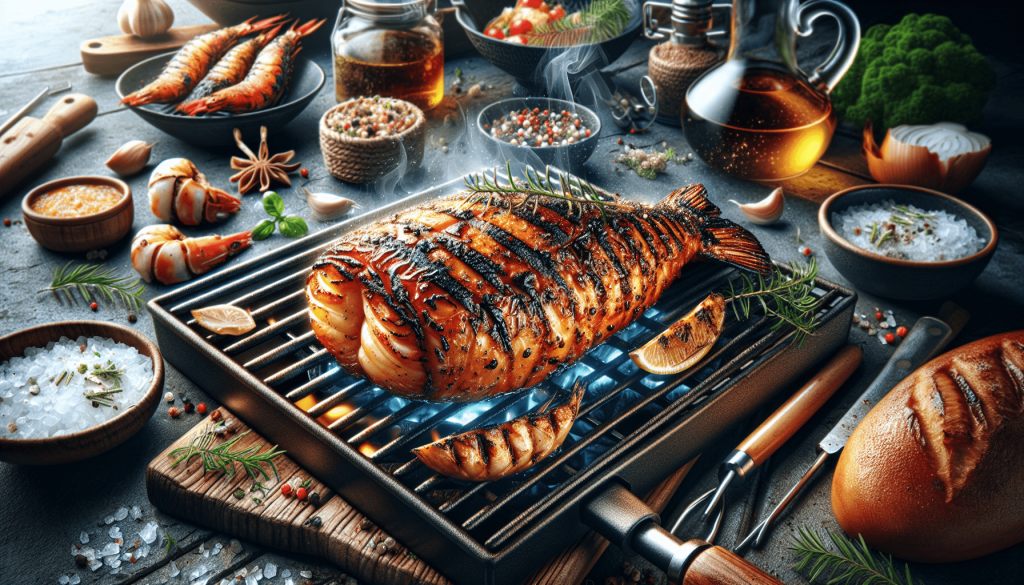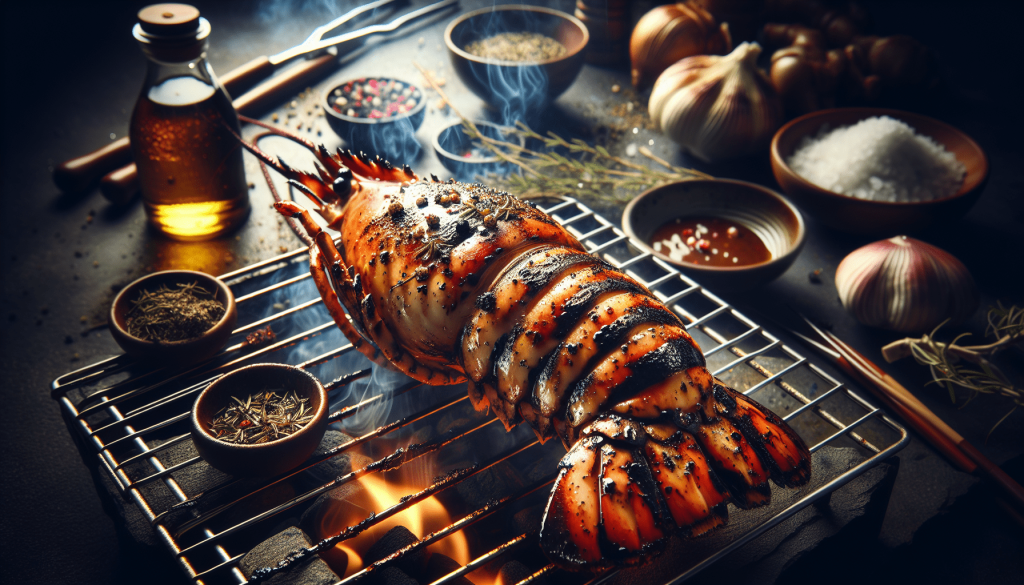Grilling seafood can be a delicious and healthy way to enjoy the fresh flavors of the ocean. Whether you’re a seafood enthusiast or just looking to add more variety to your grill, this article will explore the best techniques for grilling flavorful and tender seafood. From marinating to choosing the right type of fish, we’ll guide you through step-by-step instructions to ensure your grilled seafood is a hit every time. So grab your apron and let’s get grilling!
Choosing the Right Seafood
When it comes to grilling seafood, freshness is key. Opting for the freshest seafood ensures that you’ll enjoy the best flavor and texture when it hits the grill. So, how do you choose the right seafood? Firstly, trust your senses. Fresh seafood should have a mild, briny smell and should not smell overly fishy. Look for bright, clear eyes, shiny skin, and firm flesh. Avoid seafood that appears discolored or has any off-putting odors.
In addition to freshness, it’s important to consider the types of seafood that are best suited for grilling. Fish like salmon, tuna, swordfish, and halibut are excellent choices as they have firm flesh that holds up well on the grill. Shellfish such as shrimp, prawns, scallops, and clams also work beautifully when grilled. Consider your personal preferences and dietary restrictions when selecting your seafood options.
Lastly, sustainability should be a factor when choosing seafood. Opting for sustainably sourced seafood helps protect our oceans and ensures that future generations can enjoy the same bountiful seafood options. Look for certifications such as the Marine Stewardship Council (MSC) or the Aquaculture Stewardship Council (ASC) to make responsible choices.
Preparing the Seafood
Before you can get your seafood on the grill, it’s important to properly prepare it. If you’re working with frozen seafood, the first step is to thaw it. The best way to thaw frozen seafood is to place it in the refrigerator overnight. This gentle thawing method ensures that the seafood retains its moisture and texture.
When it comes to shellfish, such as prawns or shrimp, cleaning and deveining is an essential step. To clean shellfish, rinse them under cold water and remove any debris. Deveining involves making a shallow cut along the back of the shellfish and removing the dark “vein” that runs along its length. This step ensures a clean and appetizing presentation.
For fish with scales, you’ll want to remove them before grilling. Using a fish scaler or a blunt knife, scrape the scales away from the fish, working from tail to head. Once the scales are removed, make sure to rinse the fish thoroughly to remove any loose scales or debris. Removing scales not only enhances the appearance of the fish but also helps the marinade to penetrate the flesh evenly.

Marinating and Seasoning
Marinating seafood before grilling adds extra flavor and helps to tenderize the flesh. When choosing a marinade, consider complementing the natural flavors of the seafood. Citrus-based marinades, such as lemon or lime, work well with most seafood varieties. Asian-inspired marinades featuring soy sauce, ginger, and garlic can also add a delicious depth of flavor.
Herbs and spices are another fantastic way to enhance the taste of grilled seafood. Fresh herbs like parsley, dill, or cilantro can be chopped and mixed with olive oil or butter to create a delicious herb-infused coating. Spices like paprika, cayenne pepper, or cumin can add a subtle kick and depth of flavor. Experiment with different combinations to find your favorite seafood seasoning.
When it comes to balancing sweet and savory flavors, consider using ingredients like honey or maple syrup in your marinade. The sweetness of these ingredients can complement the natural sweetness of seafood while adding depth to the overall flavor profile. Be sure not to overdo it with the sweetness, as seafood has delicate flavors that can easily be overwhelmed.
Choosing the Right Grill
Choosing the right grill is an important decision when it comes to grilling seafood. Gas grills and charcoal grills each have their own advantages. Gas grills offer convenience and precise temperature control, making them a popular choice for many grill enthusiasts. Charcoal grills, on the other hand, provide a unique smoky flavor that can enhance the taste of grilled seafood.
Before purchasing a grill, consider the appropriate size for your needs. If you frequently entertain or have a large family, a larger grill with ample cooking space may be ideal. However, if you have limited outdoor space or only grill for smaller groups, a smaller grill may be more suitable. Take into account your lifestyle and dining habits to determine the right size for you.
If you prefer to grill indoors, there are also electric indoor grills available that can provide a similar grilling experience without the need for outdoor space. These grills are great for those who live in apartments or have limited outdoor grilling options. Consider the pros and cons of each type of grill before making a decision.

Preheating and Oiling the Grill
Before placing your seafood on the grill, it’s crucial to preheat it properly. Preheating the grill ensures that it reaches the desired cooking temperature and helps prevent sticking. For gas grills, preheat by turning on all burners to high and closing the lid for 10-15 minutes. For charcoal grills, light the coals and let them burn until they are covered with ash.
To prevent sticking, it’s important to oil the grill grates before cooking. Use an oil with a high smoke point, such as vegetable or canola oil, and apply it to the grates using a clean cloth or brush. This creates a non-stick surface and helps the seafood cook evenly. Be sure not to use too much oil, as it can cause flare-ups and affect the flavor of the seafood.
Direct and Indirect Grilling
Understanding the difference between direct and indirect grilling techniques is essential for grilling seafood to perfection. Direct grilling involves placing the seafood directly over the heat source and cooking it quickly at high heat. This method is ideal for smaller, thinner cuts of seafood and ensures that they develop a delicious charred exterior.
On the other hand, indirect grilling involves cooking the seafood away from the direct heat source, allowing for slower, more gentle cooking. This method is suitable for larger cuts of seafood or delicate seafood that may require longer cooking times without the risk of burning. Indirect grilling helps the seafood cook evenly and retains its natural moistness.
To combine the benefits of both direct and indirect grilling techniques, you can use a two-zone fire setup. For a gas grill, simply turn off one burner while keeping the other(s) on high heat. For a charcoal grill, move the hot coals to one side while leaving the other side empty. This arrangement allows you to sear the seafood over direct heat and then finish cooking it indirectly.
Grilling Time and Temperature
Grilling time and temperature are crucial factors that can determine the success of your grilled seafood. The appropriate grill temperature depends on the type of seafood you’re cooking and the desired level of doneness. As a general guideline, fish should be grilled at a medium-high heat (around 400-450°F), while shellfish can be cooked at a slightly higher temperature (around 450-500°F).
Grilling time will vary depending on the thickness and type of seafood you’re cooking. As a rule of thumb, fish fillets generally require 4-6 minutes per side, while whole fish may take a bit longer. Shellfish like shrimp and prawns cook quickly and should only take 2-3 minutes per side. It’s essential to monitor the seafood closely to avoid overcooking and drying it out.
To ensure accurate cooking, using a thermometer is highly recommended. Insert the thermometer into the thickest part of the fish or the center of the seafood to get an accurate reading. Fish should reach an internal temperature of 145°F, while shellfish should reach 120-130°F. Remember to remove the seafood from the grill just before it reaches the desired internal temperature, as it will continue to cook slightly even after being removed from the heat.
Grilling Techniques for Different Seafood
Grilling whole fish is a great way to showcase its natural flavors and beautiful presentation. To grill a whole fish, make sure it’s gutted and scaled. Season the fish with salt, pepper, and any desired herbs or spices. Cook the fish over direct medium-high heat for approximately 4-6 minutes per side, or until it reaches an internal temperature of 145°F. Serve it whole or fillet it before serving.
Shrimp and prawns are excellent options for grilling, as they cook quickly and develop a delightful charred flavor. To grill shrimp and prawns, simply skewer them or use a grilling basket to prevent them from falling through the grates. Cook them over direct high heat for approximately 2-3 minutes per side, or until they are pink and opaque. Be careful not to overcook them, as they can become rubbery.
Shellfish such as scallops, clams, and squid can also be grilled to perfection. For scallops, make sure they are dry and season them with salt and pepper. Grill them over direct medium-high heat for approximately 2-3 minutes per side, or until they develop a golden crust. For clams, place them directly on the grill grates and cook for about 4-5 minutes, or until they open. Clean squid thoroughly, season, and grill over direct medium-high heat for approximately 3-4 minutes per side, or until opaque and slightly charred.
Grilling Accessories and Tools
To make your grilling experience even more enjoyable, there are a few accessories and tools that can come in handy. Grill baskets and grilling mats are great for cooking seafood that may otherwise fall through the grates. These accessories provide a stable surface for delicate seafood and make flipping easier. Fish spatulas or tongs are essential for safely flipping and removing seafood from the grill without damaging it.
A grill thermometer is a must-have tool for ensuring accurate cooking temperatures. It allows you to monitor the doneness of your seafood and helps prevent undercooking or overcooking. A timer can also be useful to keep track of cooking times, especially when grilling multiple pieces of seafood simultaneously.
Serving and Enjoying Grilled Seafood
Once your grilled seafood is cooked to perfection, it’s time to serve and enjoy it. Garnishing and presentation play an essential role in making your grilled seafood look appetizing. Sprinkle fresh herbs, such as parsley or dill, on top of the seafood to add a pop of color. Squeezing some lemon or lime juice over the seafood right before serving can enhance the flavors and provide a refreshing contrast.
Accompaniments and sauces can further enhance the enjoyment of grilled seafood. Classic options include lemon butter sauce, garlic aioli, or a tangy salsa verde. Serve the seafood alongside grilled vegetables, a vibrant salad, or a flavorful rice dish to create a complete and satisfying meal.
Lastly, it’s important to follow food safety guidelines when handling and serving grilled seafood. Ensure that the seafood is cooked to the appropriate internal temperature to kill any potential bacteria. Store any leftovers promptly in the refrigerator and consume them within a day or two. By following these precautions, you can safely savor your grilled seafood without any unwanted foodborne illnesses.
In conclusion, grilling seafood can be a delicious and rewarding culinary experience. By choosing the right seafood, preparing it properly, and employing the best grilling techniques, you can achieve flavorful and tender results every time. So fire up the grill, grab your favorite seafood, and get ready to enjoy a memorable seafood feast. Happy grilling!
